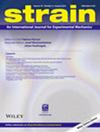使用分裂霍普金森杆技术测试脆性材料的方法学方面
IF 2.4
3区 材料科学
Q2 MATERIALS SCIENCE, CHARACTERIZATION & TESTING
引用次数: 6
摘要
本文以砂浆为例,介绍了一种利用Hopkinson分裂杆技术测定脆性材料动态性能的方法的特点。实验在有和没有加载脉冲整形器的情况下进行,该整形器是放置在输入棒受冲击端的可变形铜盘(衬垫)。基于测量棒中脉冲的Pochhammer–Chree频率方程的直接解,在进行色散校正和不进行色散校正的情况下处理来自无垫实验的实验数据。比较了分裂霍普金森压杆实验的三种变体的受试材料的变形图和力学特性:有和没有加载脉冲整形器,以及测量杆中脉冲的色散校正程序。描述并讨论了在这些实验方案中观察到的现象以及对所获得数据的处理;进一步,揭示了负荷增加的性质的影响。本文章由计算机程序翻译,如有差异,请以英文原文为准。
Methodological aspects of testing brittle materials using the split Hopkinson bar technique
This paper presents the features of a method for determining the dynamic properties of brittle materials using the split Hopkinson bar technique on mortar as an example. Experiments were conducted both with and without a loading pulse shaper, a deformable copper disc (pad) placed on the impacted end of the input bar. Experimental data from the experiments without the pad were processed with and without dispersion correction based on a direct solution of the Pochhammer–Chree frequency equation of pulses in the measuring bars. There were compared both the deformation graphs and mechanical characteristics of the tested material for three variants of the split Hopkinson pressure bar experiments: with and without a loading pulse shaper, and with the dispersion correction procedure for pulses in the measuring bars. The phenomena observed during these experimental schemes and the processing of obtained data are described and discussed; further, the effect of the nature of the load increase is revealed.
求助全文
通过发布文献求助,成功后即可免费获取论文全文。
去求助
来源期刊

Strain
工程技术-材料科学:表征与测试
CiteScore
4.10
自引率
4.80%
发文量
27
期刊介绍:
Strain is an international journal that contains contributions from leading-edge research on the measurement of the mechanical behaviour of structures and systems. Strain only accepts contributions with sufficient novelty in the design, implementation, and/or validation of experimental methodologies to characterize materials, structures, and systems; i.e. contributions that are limited to the application of established methodologies are outside of the scope of the journal. The journal includes papers from all engineering disciplines that deal with material behaviour and degradation under load, structural design and measurement techniques. Although the thrust of the journal is experimental, numerical simulations and validation are included in the coverage.
Strain welcomes papers that deal with novel work in the following areas:
experimental techniques
non-destructive evaluation techniques
numerical analysis, simulation and validation
residual stress measurement techniques
design of composite structures and components
impact behaviour of materials and structures
signal and image processing
transducer and sensor design
structural health monitoring
biomechanics
extreme environment
micro- and nano-scale testing method.
 求助内容:
求助内容: 应助结果提醒方式:
应助结果提醒方式:


